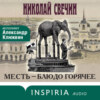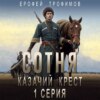Книгу нельзя скачать файлом, но можно читать в нашем приложении или онлайн на сайте.
Читать книгу: «Packing and Portaging», страница 2
CHAPTER V
FOOD
THE true wilderness voyager is willing to endure some discomforts on the trail, to work hard and submit to black flies and other pests, but as a reward he usually demands satisfying meals. There is, indeed, no reason for him to deny himself a variety and a plenty, unless his trip is to extend into months. Weight on the portage trail is always the consideration that cuts down the ration. Packing on one's back a ration to be used two or three months hence is discouraging.
I have evolved a two-week food supply for two men, based upon the United States army ration, varied as the result of my own experiences have dictated. It offers not only great variety, but is an exceedingly bountiful ration even for hungry men. Personal taste will suggest some eliminations or substitutions that may be made without material loss or change in weight. If there is certainty of catching fish or killing game, or if opportunity offers for purchasing fresh supplies along the trail, reductions in quantity may be made accordingly. For each additional man, or for any period beyond two weeks, a proportionate increase in quantity may be made.
Bacon, 6 pounds.
Salt fat pork, 2 pounds.
Ham or canned meats, 5 pounds.
"Truegg" (egg powder), 1 pound (equals 4 dozen eggs.)
"Trucream" (milk powder), 11/2 pounds.
"Crisco," 3 pounds, (2 cans).
Fresh bread, 2 pounds.
Flour, 12 pounds.
Corn meal (yellow), 1 pound.
Rolled oats, 1 pound.
Rice, 1 pound.
Baking powder, 1/2 pound.
Potatoes (Dehydrated) riced, 2 pounds (equals 14 lbs. fresh potatoes).
Potatoes (Dehydrated) sliced, 1 pound (equals 7 lbs. fresh potatoes).
Carrots (Dehydrated), 1/4 pound (equals 3 lbs. fresh carrots).
Onions (Dehydrated), 1/4 pound (equals 33/4 lbs. fresh onions).
Cranberries (Dehydrated), 1/4 pound (equals 21/2 qts. fresh fruit).
Beans, 2 pounds.
Green peas (Dehydrated), 1/4 pound (equals 11/4 lbs. fresh peas).
Coffee (ground), 2 pounds.
Tea, 1/2 pound.
Cocoa, 1/2 pound.
Sugar (granulated), 5 pounds.
Preserves, 1 pound.
Lemons, 1/2 dozen.
Lime tablets, 1/2 pound.
Prunes (stoned), 1 pound.
Raisins, 1 pound.
Salt, 1 pound.
Pepper, 1/4 ounce.
This gives each man a nominal ration of 141/2 pounds a week, or about two pounds a day. In reality, however, it is more bountiful than the summer garrison ration and far more liberal than the summer marching ration of the army. This is brought about by the pretty general elimination of water, largely through the substitution of dehydrated vegetables and fruits for fresh and canned goods. The dehydrated products designated are in every particular equal to fresh products and far superior to canned goods. Dehydrated vegetables possess all the qualities, in fact, of fresh vegetables, with only the large percentage of water removed. Water is introduced restoring them to original form usually by boiling. No chemical is used as a preservative as is the case with all dried vegetables put up by foreign manufacturers.
It will be noticed that butter has been omitted and that "Crisco" has been introduced in the place of lard and to be used in cooking instead of butter. Crisco is a product of edible vegetable oils. It has the appearance of lard but can be heated to a much higher temperature without burning, is fully equal to butter when used as shortening, and dough bread, fish or other articles of food fried in it will not absorb it so readily as they will lard, nor will it transmit the flavor of one food to another. For example, fish may be fried in Crisco, and dough bread or anything else fried in the same Crisco will have not the slightest flavor of fish. It will keep fresh and sweet under conditions that turn lard and butter rancid. Butter quickly becomes strong, and the heat of the sun keeps it in an oily, unpalatable condition, even when packed in air-tight tins. The most lavish user of butter will discover that it is no hardship to go without it when in camp. Crisco, put up in handy, friction-top cans, can be purchased from nearly any grocer.
Coffee should be carried in friction-top tins. On extended trips coffee is too bulky to carry save as a special treat. A pound of tea will go as far as many pounds of coffee; therefore on trips extending beyond three or four weeks the proportion of tea should be increased and that of coffee diminished. On short trips, however, such as we are discussing, there is no reason and most Americans usually prefer it even when in camp.
Each article of food should have its individual bag, to fit into one of the larger waterproof canvas bags described, though the bacon and fat pork, each piece wrapped in paraffin (waxed) paper, may be packed in one bag. Paraffin paper will protect other packages in the bag from grease. Several articles of small bulk and weight such as dehydrated carrots, onions, cranberries and green peas each in its original package or a small muslin bag suitable in size may be carried in a single balloon silk bag. The small bags containing such articles as are not in daily and frequent use should be stowed in the bottoms of the canvas bags, while those in constant demand should be at the top where they can be had without unpacking the entire bag. Every package or bag should be plainly labeled with the nature of its contents. In labeling them use ink, as pencil marks are too easily obliterated. Where a party is composed of a sufficient number of people to make it worth while the party ration for each day may be weighed out and packed in a separate receptacle, thus making seven food packages for each week. This, however, would be obviously unpractical where there are less than eight or ten members of the party.
No glass or crockeryware should be used, not only because of its liability to break, but because of its unnecessary weight.
A good way to carry the tin of baking powder is to sink it into the sack of flour. The flour will protect it and preclude the possibility of the cover coming off and the contents spilling out. Do not carry prepared or self-raising flour on the trail. For many reasons it is unpractical for trail use, though perhaps most excellent in the kitchen at home.
Throughout I have accentuated the advisability of waterproof covers for everything. Every ounce of water absorbed by tent, bags, or package covers, adds to the tedium of the trail by so much unnecessary weight. When flour carried in an ordinary sack Is exposed to rain a paste will form next the cloth, and presently harden into a crust that will protect the bulk of flour from injury. But the flour used up in the process of crust forming is a decided waste, and the paste, retaining a degree of moisture, increases weight.
I have suggested balloon silk for the small food bags to fit into the larger waterproofed canvas bags, not only because it does not absorb moisture, but because there will be no possibility of the contents sifting through the cloth. If these or the cloth from which to make them cannot be readily obtained, closely woven muslin will do.
Should the canoeist desire to make his own bags and should he not find it convenient to purchase waterproofed canvas, the ordinary canvas which he will use may be waterproofed by the following process:
In two gallons of boiling water dissolve three and one-half ounces of alum. Rain water is best, though any soft water will do; but it must be soft water to obtain the best results. In another vessel dissolve four ounces of sugar of lead in two gallons of soft water. Unite the solutions when they have cleared by pouring into another vessel No. 1 first, then No. 2. Let the solution stand over night, decant it into a tub, free of any sediment that may have settled, and it is ready for the canvas. The cloth should be put into the solution, thoroughly saturated with it and then lightly wrung out, and hung up to dry. This treatment will render canvas to a considerable extent, though not completely, waterproof.
Muslin for the smaller food bags may be waterproofed by painting it with a saturate solution of turpentine and paraffin.
Canned goods should be packed snugly in canvas bags, with cans on end, that the sides, not the corners or edges, will rest against the back in portaging.
Camp chests in which to store food or other articles are carried by some canoeists, but they add considerable weight to the outfit. The best and most serviceable camp chest is one of indestructible fiber. One with an inside measurement of 18 × 24 × 12 inches weighs twenty pounds.
CHAPTER VI
THE PORTAGE
THERE are several types of pack harness offered by outfitters, but it is generally conceded that the best method of carrying heavy or medium-weight packs is with the tump line. In tump line carrying the pack is supported by a broad band of leather passed across the head—high up on the forehead—thus throwing the weight upon the strong muscles of the neck, with no shoulder straps or other support.
Canadian voyageurs, Hudson's Bay Company packers and Indians use the tump line to the exclusion of all shoulder-carrying devices. Indeed, by no other method would it be possible for them to transport upon their backs through a rough country the heavy burdens which they are called upon to carry. Experienced packers with the tump line will sometimes portage loads of upwards of four hundred pounds. In tests of skill I have seen a man carry in a single load the contents of three barrels of flour—588 pounds.
The tump line consists of a broad piece of leather some eighteen or twenty inches in length (known as the head strap or headpiece), with a leather thong usually about seven feet in length attached to each end, the total length from the tip end of one thong to the tip end of the other thong averaging about sixteen feet.
Sometimes the two thongs are sewn to the headpiece, and again the line is a single strip of leather, broadened in the center to form the headpiece. The best tump lines, however, have the head strap as a separate piece with a buckle at each end by which the thongs are attached. This arrangement admits of adjustment, if necessary, to suit the individual after the pack has been made up.
There is a knack in tump line carrying, but the following directions for making up various packs will give the novice sufficient insight, with a little experience, to enable him to acquire the art.
When the pack is to be made up wholly of bags, lay the tump line on the ground with the thongs parallel to each other and from sixteen to twenty inches apart, depending upon the length of the bags to be packed. Place the bags across the thongs, one bag upon another, taking care that the thongs are not so near the ends of the bags as to render them liable to slip off when the pack is tied. Now lift the head strap above the top bag and secure the pack by drawing the loose end of each thong in turn tight around the bags and knotting it a few inches below the buckle that attaches its other end to the headpiece.
When a pack cloth is to be used, spread the pack cloth upon the thongs of the tump line, stretched upon the ground in the manner above described, and in the center of the pack cloth lay folded blankets and other articles to be packed, making the pile about two feet long, and taking care that hard substances are in the center, with blankets and soft things outside. Now turn the sides of the pack cloth over the pack and fold over the ends. If a bag is to be included, lay it upon the pack after the cloth has been folded, and secure the whole as in the former case.
Another method of making up a pack with the pack cloth, common among Canadian voyageurs, is as follows: Spread the cloth upon the ground, and lay the tump line across it, the headpiece near one end and the thongs a foot from the sides. Fold the sides of the cloth inward over each thong. Now build up the pack in a neat pile about two feet long on the folded cloth, taking care as before that hard things are placed in the middle. Fold the end of the pack cloth with protruding thongs over the pack, take a half turn with the loose end of a thong around the other end near the headpiece, draw it tight until the end is closely puckered, then knot it and draw up the other thong and secure it in like manner. Now bring the free ends of the tump line to center of pack, on top, cross them and pass them around middle of pack and tie.
The knack of comfortable tump line carrying once the neck muscles have become developed and hardened to the work is in properly balancing the pack. With the headpiece resting high up upon the forehead the pack should hang with its bottom no lower than the hips. Neither should it be too high. A little experimenting will teach just where the proper balance is to be found. If it is too high, lengthen the line, or if too low shorten it by means of the buckles which attach the thongs to the headpiece.
Experienced packers pile additional bags or bundles on top of the pack, the uppermost bundle standing higher than the head. In my own experience I have found that an additional bag thus placed upon the pack and resting against the back of my neck helped balance the load. My favorite bag for this purpose is a forty or fifty pound bag of flour, sometimes surmounted by a lighter bundle which rested partly upon the flour and partly upon my head.
The tenderfoot will be quite content to limit his early loads to sixty or seventy pounds, and even then his first portages will not be what he can conscientiously term experiences of unalloyed joy. Gradually, however, he will learn the knack of tump packing and at the end of a couple of weeks of daily experience will find himself able to negotiate a load of one hundred pounds with some ease.
All the various types of pack harness are supplied with straps by which the pack is secured and loops through which to slip the arms, the pack being carried from the shoulders instead of the head. With this sort of a pack, as with the tump line, care should be given to the proper adjustment, with the bottom of the pack no lower than the hips. Fifty pounds is about as heavy a load as one can comfortably carry from the shoulders.
Outfitters sometimes attach a headpiece to their pack harness—that is to say the harness is provided with both shoulder loops and tump line head strap. The object is to secure a division of weight between shoulders and head. This is a method employed by Eskimos when hunting without dogs. The Eskimo hunter binds his pack with sealskin thongs, and manipulates a single thong in such a manner as not only to secure the pack but to form arm loops and headpiece as well.
No matter what type of shoulder harness is employed, a breast strap must be used to fasten together the arm loops in front or the loops will have a continual tendency to slip backward and off the shoulders. This breast strap fastens the packer so securely to his pack that should he slip, as is sometimes likely, the pack will carry him down with it and the probability of injury is multiplied many times. This alone is a very decided objection to all forms of pack harness.
If one slips with a tump line, on the contrary, a slight twist of the head will disengage and free one from the pack; and if one is hunting the tump pack may readily be dropped at a moment's notice, should game be sighted.
Let me therefore urge the adoption of the tump line for all portage work where fifty pounds or more must be transported. No experienced packer will use harness. Harness packing is indeed indicative of the tenderfoot who has never learned how, unless on long cross country tramps with light loads.
But on a canoe trip, if one would make progress, big loads must be resorted to. For instance, if the canoeist has a two mile portage to negotiate and one hundred pounds of duffle he has but two miles to walk if he carries all his duffle at once, but if he makes two loads of it he must walk six miles. With the hundred pound load the portage may easily be covered in one hour. With fifty pound loads three hours will be consumed, for there will be time lost in making up the second pack.
Axes, guns and extra paddles may be thrust under the thongs of the tump line, or carried in the hand. Never portage a rifle with a cartridge in the chamber, and never portage a loaded shotgun. To disregard this advice will be to take an unnecessary and foolhardy risk.
Save in a rather stiff breeze, one man can carry a canoe weighing less than one hundred pounds nearly as easily as two can carry it. There is one best way of doing everything, and the best and most practical way to carry a canoe is the Indian's way.
Tie one end of a stout string or thong securely to the middle thwart close to the gunwale, and the other end to the same thwart close to the opposite gunwale with the string stretched taut from end to end of the thwart and on top of it. Slip the blades of two paddles, lying side by side, under the string, the paddle handles lying on the forward thwart. With the handles as close together as they will lie, bind them with a piece of rope or thong to the center of the forward thwart.
Spread the blades upon the middle thwart sufficiently wide apart to admit your head between them. Take a position on the left side of the canoe facing the stern. Just forward of the middle thwart grasp the gunwale on the opposite or right side of the canoe in your left hand and the gunwale on the near or left side in your right hand, and, lifting the canoe over your head, let the flat side of the paddles directly forward of the middle thwart rest upon the shoulders, your head between them. It will be found that though you faced the stern in lifting the canoe you are now facing the bow, and with the bow slightly elevated the canoe can be carried with ease and a view of the trail ahead will not be shut out.
Should the flat paddle blades resting upon the shoulders be found uncomfortable, as they doubtless will at the end of the first two or three hundred yards, a Pontiac shirt or sweater will serve as a protecting pad.
Outfitters offer for sale yokes, pneumatic pads and contrivances of various sorts as protections for the shoulders, but these contrivances elevate the canoe from two to four inches above the shoulders and this increases the difficulty of steadying it on rough trail. The sweater or Pontiac shirt eases the cutting effect of the paddles just as well as any of the special portaging pads, and the canoe can be handled more easily with it. Besides it makes one less thing to look after.
In a strong breeze it is often difficult for one man to handle a canoe, for the wind striking it on the side will turn the portager around and he will find it impossible to keep his course in spite of his best efforts. If the portage is a short one—two or three hundred yards—the canoe may be carried very well, one man with the bow the other with the stern upon a shoulder, the canoe on its side with the bottom next the portagers' heads, that they may easily grasp the gunwale in one hand and steady the canoe with the other.
This position will soon be found exceedingly tiresome, and on portages exceeding two or three hundred yards the paddles should be arranged with the blades on the after thwart and the handles lashed to the center of the middle thwart. With this arrangement one man carries exactly as when portaging the canoe alone, save that he stands under the canoe just forward of the after thwart instead of the middle thwart, while the other man carries the bow upon one shoulder. This is the easiest method of two-man portaging of which I know.
Many odds and ends may be tucked in the canoe on the portage—fishing rods, for example, in cases, with one end stuck in the bow and the other end tied to the forward thwart.
Should a canvas canoe become punctured it may be repaired by one of the following methods:
If a stick of canoe cement is in the outfit, heat the cement with a match and smear it over the puncture.
Should the outfit contain a canoe repair kit, cut a patch of canvas somewhat larger than the puncture, apply a coat of white lead to the puncture and over a marginal space as large as the canvas patch, press the patch firmly and evenly upon the white lead and tack it down with copper tacks. To this apply calor, and when dry complete the repairs with a coat of varnish.
Should marine glue be used, lay a sheet of it over the puncture, heat the bottom of a cup or some other smooth metal utensil and rub it over the glue until the glue melts sufficiently to fill the puncture.
In a region where spruce gum can be had, melt a quantity of gum in a frying pan with sufficient grease to take from the gum its brittle quality when cold. While hot pour the gum upon the rupture, letting it run well into the opening and smearing it smoothly over the outside.
"Peterborough" canoes are also easily repaired with marine glue or gum.
In loading the canoe place the heavier bags in the bottom and middle of the canoe, taking care so to distribute the weight that when fully loaded the canoe will lie on an even keel. Keep the load always as low down as possible. Every bag rising above the gunwales offers resistance to the wind, and tends to make the load topheavy. When but one man occupies a canoe, however, sufficient weight should be carried forward to counterbalance his weight in the stern.
Lash everything fast, particularly in rough water or when running rapids. It does not pay to take chances. With a companion I was once turned over in a rapid in an unexplored, sparsely timbered wilderness several hundred miles from the nearest base of supplies—a Hudson's Bay trading post. Nearly all our food was lost, as well as guns, axes, cooking utensils and many other necessities of travel. The temperature stood close to zero, snow covered the ground and during the greater part of the three weeks occupied in reaching the post we had to dig driftwood from under the snow, and our ingenuity was taxed at times to the utmost in efforts to protect ourselves from the elements and travel with any degree of comfort. Nothing worse than an unpleasant ducking in icy waters would have resulted from our accident had we observed the rule of ordinary caution and lashed our outfit to the thwarts.
One end of a rope tied to the forward thwart, the other end threaded through bag handles or pack lashings and secured to the after thwart, will do the trick. A short strap, one end attached to a thwart, the other end supplied with a snap to fasten on rifle or shotgun cases, is a good way to secure the guns and still have them readily accessible.
If you would make speed be smart in unloading the canoe and making up your packs on the portage, and equally smart in reloading the canoe. Delays in loading, unloading and making up packs are the chief causes of slow progress.
When it is found necessary to "track," give the rear end of the tracking line a turn around the forward thwart, on the land side of the canoe, then pass the end back and secure it to the middle thwart. This distributes the strain between the thwarts. While one man at the farther end of the line tows the canoe, the other man with a pole may walk upon the bank, and keep the canoe clear of snags, if the water is deep. Should the water be shallow it will usually be found necessary for him to wade and guide the bow through open channels.
























